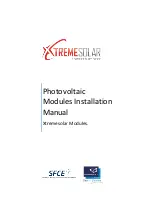
KTA141001 Ver. 1.00
- 13 - Installation manual for PV modules
6. WIRING
To ensure proper system operation and to maintain your guaranty,
observe the correct cable connection polarity (Figure 3) when
connecting the modules to a battery or to other modules. If not
connected correctly, the bypass diode could be destroyed.
PV modules can be wired in series or in parallel according to
Installation Manual of PV module.
All the modules must have positive potential to the ground. Care must
be taken to arrange the system ground so that the removal of one
module from the circuit will not interrupt the grounding of any of the
other modules.
CAUTION!: Please keep the open-circuit condition in the PV
modules before completing the electrical wiring of PV system.
< For US market >
Details for wiring shall be in accordance with the NEC and grounding
method of arrays shall comply with the NEC. The ground wire must not
be smaller than No.12 AWG, and should be sized according to the
NEC.
The PV source-circuit overcurrent devices (
e.g.
Fuses) are required to
be rated so that the source-circuit conductors are protected in
accordance with Article240 and so that the overcurrent device ratings
do not exceed the maximum overcurrent device rating marked on the
modules as shown in Figure 4. Possible backfeed currents from the
other PV source circuits, other supply sources through the inverter, and
storage-battery circuits, if any, have to be considered.
7. INSTALLATION
Refer to installation manual of PV module.
CAUTION!: Do not keep PV modules without grounded condition
by minus-pole after series connection, TCO corrosion may be
caused.
8. ELECTRICAL RATINGS
Refer to installation manual of PV module.
9. GROUNDING
The mounting structure of the modules must be grounded in
accordance with applicable law of each country.
<For US market>
The grounding method of arrays shall comply with the NEC, article
250.
10. MOUNTING
Please make sure that all the information described in the installation
manual is still valid and proper for your installation. The mounting
method has been verified by SHARP and NOT CERTIFIED by a third
party organization.
Although Sharp does not specify or warrant clips or clamps, using clips
(not provided) or clamps (not provided) is also possible when they are
designed for PV modules and with minimum dimensions on the sides
of the module in accordance with the instructions and drawings
provided. If using clips or clamps, the modules should be fixed rigidly
by the tool which can be controlled the tightening torque (torque
wrench etc) so that the module should not slip down and there shall be
no damage to the modules by deforming mounting structure against
design load. The Sharp module guaranty may be void if
customer-selected clamps which are improper or inadequate with
respect to the module properties (including strength or material) or
installation. Note that if metal clamps are used, there must be a path to
ground from the clamps, (for instance, using star washers in the clamp
hardware set).
Please review the descriptions and drawings carefully; not mounting
the modules according to one of these methods may void your
guaranty. Support structures that PV modules are mounted on should
be rigid. Sharp PV modules are designed to secure their electric
performance under the condition that they are mounted on rigid
support structures. Deformation of support structure may damage PV
module with its electric performance.
11. MAINTENANCE
The modules are designed for long life and require very little
maintenance. If the angle of the PV module is 5 degrees or more,
normal rainfall is sufficient to keep the module glass surface clean
under most weather conditions.
If dirt build-up becomes excessive, clean the glass surface by using
water. If cleaning the back of the module is required, take utmost care
not to damage the back side materials. Please avoid the cleaning with
water when there is a danger of frost and strong temperature
differences between the module, water and air. Hard water used as a
cleaning agent should be decalcified beforehand in order to avoid
water staining. Remove any standing water from the module.
In order to ensure the operation of the system, please check the
connection of wiring and the state of the jacket of wires every now and
then.
Figure 4
SERIES WIRING (VOLTAGE ADDITIVE)
SERIES WIRING (VOLTAGE ADDITIVE)
PARALLEL WIRING (CURRENT ADDITIVE)
Figure 3
Modules
Fuses
+
+
+
+
-
-
-
-
+
+
+
+
-
-
-
-
+
+
+
+
-
-
-
-
+
+
+
+
-
-
-
-
+
+
+
+
-
-
-
-
+
+
+
+
-
-
-
-
+
+
+
+
-
-
-
-
+
+
+
+
-
-
-
-


































